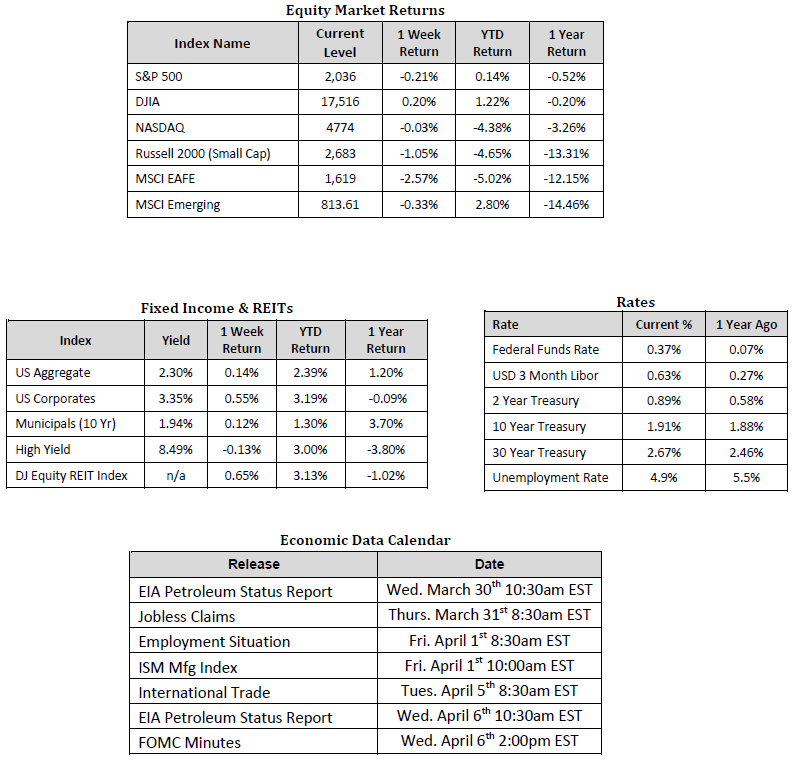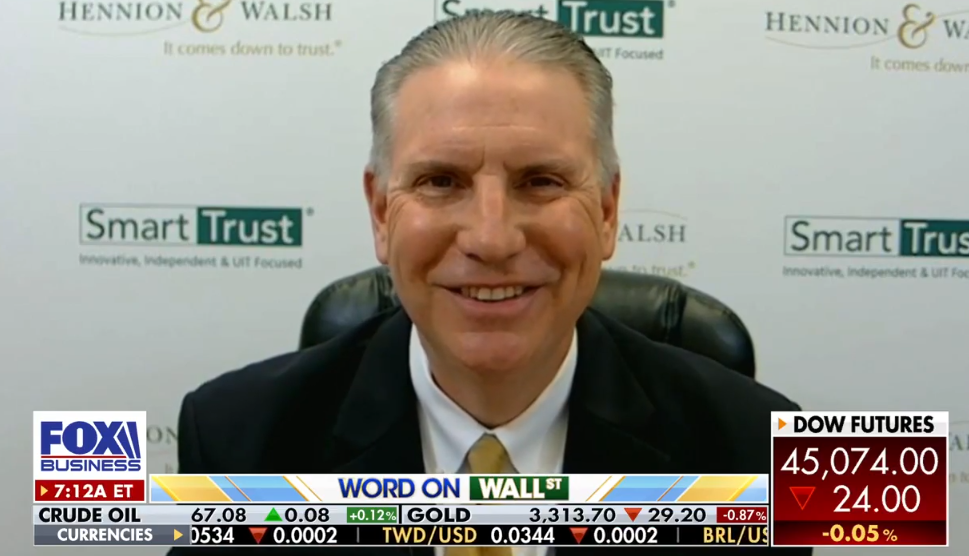
Upside Risk to Inflation May Force Fed’s Hand Earlier than Many Currently Expect
Market Overview

Sources: Equity Market, Fixed Income and REIT returns from JP Morgan as of 03/24/16. Rates and Economic Calendar Data from Bloomberg as of 03/28/16.
Happening Now
U.S. stocks* broke a five week winning streak, falling 0.2% during the holiday shortened 4 day trading period last week. Following the tragic attacks in Brussels in addition to mixed economic data that was reported, markets exhibited range-bound trading, not rising or falling more than 1% during any one day. The third estimate for quarter four 2015 GDP, released Friday while markets were closed, came in better than expected by rising 1.4%. This was better than the 1.0% gain reported during the second estimate, which in turn was an improvement from the initial release which showed a 0.7% gain. The upside to GDP was due in part to stronger than expected consumer spending, the largest component of the U.S. economy at present.
With persistent improvement in employment, rising wages, and increasing oil prices*, Federal Reserve members are now pointing to upside risk in terms of inflation expectations. Five Fed Bank Presidents spoke last week and four of the five suggested that if the economy continues to evolve as expected, additional rate hikes may not be far off. Jeffrey Lacker (Richmond Fed President), Dennis Lockhart (Atlanta Fed President), Patrick Harker (Philadelphia Fed President), and James Bullard (St. Louis Fed President and the only voting member of this group) all suggested that rising inflation indicators and continued improvement in the economy will force the Fed’s hand earlier this year than markets currently expect. Charles Evans (Chicago Fed President), perhaps the most dovish of the twelve Bank Presidents, believes a “wait and see” approach may be best to ensure that when inflation does rise above the 2% goal, it is not just temporary.
According to the CME Group, there is only an 8% probability of a rate hike at the next meeting of the Federal Open Market Committee (FOMC), which is set for April 27. Given the uncertainties surrounding economic growth, inflation, and monetary policy, there are a number of opportunities for stock market investors to be caught off guard in 2016. In light of this environment, we are suggesting that investors consider the lessons that they may have learned in January and February about their own risk tolerance levels to ensure their investment strategy is capable of reaching their long term goals without a level of risk that may tempt them to make abrupt changes to their allocations to stocks, bonds and cash.
*U.S. Stocks are represented by the S&P 500 Index. Oil Prices are represented by WTI Crude.
Important Information and Disclaimers
Disclosures: Hennion & Walsh is the sponsor of SmartTrust® Unit Investment Trusts (UITs). For more information on SmartTrust® UITs, please visit www.smarttrustuit.com. The overview above is for informational purposes and is not an offer to sell or a solicitation of an offer to buy any SmartTrust® UITs. Investors should consider the Trust’s investment objective, risks, charges and expenses carefully before investing. The prospectus contains this and other information relevant to an investment in the Trust and investors should read the prospectus carefully before they invest.
Investing in foreign securities presents certain risks not associated with domestic investments, such as currency fluctuation, political and economic instability, and different accounting standards. This may result in greater share price volatility. These risks are heightened in emerging markets.
There are special risks associated with an investment in real estate, including credit risk, interest rate fluctuations and the impact of varied economic conditions. Distributions from REIT investments are taxed at the owner’s tax bracket.
The prices of small company and mid cap stocks are generally more volatile than large company stocks. They often involve higher risks because smaller companies may lack the management expertise, financial resources, product diversification and competitive strengths to endure adverse economic conditions.
Investing in commodities is not suitable for all investors. Exposure to the commodities markets may subject an investment to greater share price volatility than an investment in traditional equity or debt securities. Investments in commodities may be affected by changes in overall market movements, commodity index volatility, changes in interest rates or factors affecting a particular industry or commodity.
Products that invest in commodities may employ more complex strategies which may expose investors to additional risks.
Investing in fixed income securities involves certain risks such as market risk if sold prior to maturity and credit risk especially if investing in high yield bonds, which have lower ratings and are subject to greater volatility. All fixed income investments may be worth less than original cost upon redemption or maturity. Bond Prices fluctuate inversely to changes in interest rates. Therefore, a general rise in interest rates can result in the decline of the value of your investment.
Definitions
MSCI- EAFE: The Morgan Stanley Capital International Europe, Australasia and Far East Index, a free float-adjusted market capitalization index that is designed to measure developed-market equity performance, excluding the United States and Canada.
MSCI-Emerging Markets: The Morgan Stanley Capital International Emerging Market Index, is a free float-adjusted market capitalization index that is designed to measure the performance of global emerging markets of about 25 emerging economies.
Russell 3000: The Russell 3000 measures the performance of the 3000 largest US companies based on total market capitalization and represents about 98% of the investible US Equity market.
ML BOFA US Corp Mstr [Merill Lynch US Corporate Master]: The Merrill Lynch Corporate Master Market Index is a statistical composite tracking the performance of the entire US corporate bond market over time.
ML Muni Master [Merill Lynch US Corporate Master]: The Merrill Lynch Municipal Bond Master Index is a broad measure of the municipal fixed income market.
Investors cannot directly purchase any index.
LIBOR, London Interbank Offered Rate, is the rate of interest at which banks offer to lend money to one another in the wholesale money markets in London.
The Dow Jones Industrial Average is an unweighted index of 30 “blue-chip” industrial U.S. stocks.
The S&P Midcap 400 Index is a capitalization-weighted index measuring the performance of the mid-range sector of the U.S. stock market, and represents approximately 7% of the total market value of U.S. equities. Companies in the Index fall between S&P 500 Index and the S&P SmallCap 600 Index in size: between $1-4 billion.
DJ Equity REIT Index represents all publicly traded real estate investment trusts in the Dow Jones U.S. stock universe classified as Equity REITs according to the S&P Dow Jones Indices REIT Industry Classification Hierarchy. These companies are REITSs that primarily own and operate income-producing real estate.



